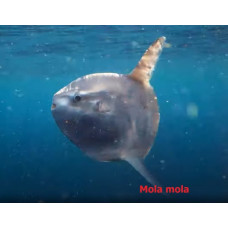From the Greek: ἰχθύς, ikhthus, "fish"; and πλαγκτός, planktos, "vagrant".
Ichthyoplankton is a collective name for floating eggs and larvae of bony fishes. The period of stay of eggs in Ichthyoplankton is not more than 2-3 days, larvae in Ichthyoplankton are on average about 2 months, some spend in Ichthyoplankton for 3 years (larvae of European eel).
A type of zooplankton, which is an aggregate of pelagic eggs, pelagic larvae and juvenile fish, as well as adult fish permanently living in the water column - pelagial, unable to resist currents. Ichthyoplankton are found in fresh, brackish and marine waters. Typical planktonic fish have a limited capacity for active swimming at all stages of the life cycle.
The term "ichthyoplankton" is usually considered in a narrow sense, referring only to the pelagic embryonic and early ontogenetic stages of larval and juvenile fish, while in a broader sense it also includes all marine finfish that are not capable of active horizontal movements. The distribution of ichthyoplankton in freshwater, mainly in rivers, is downstream. In marine waters, ichthyoplankton migration is carried out both within the shelf and outer shelf zone, as well as in the open ocean and over oceanic submarine rises, due to drift with water masses of coastal and large ocean currents.
Ichthyoplankton plays an important role in the nutrition of both fish and other vertebrate and invertebrate hydrobionts.
In freshwater bodies, ichthyoplankton includes mainly pelagic fish eggs and larvae, for example, in such Cyprinidae pelagophile fishes as Pelecus cultratus, bleak Alburnus alburnus and Far Eastern fishes Hypophthalmichthys molitrix and Aristichthys nobilis.
Oceanic ichthyoplankton includes both early pelagic stages of fish development and many adult fish inhabiting the pelagial zone. From marine fishes to ichthyoplankton include dwarf, 2-5 cm long, fishes inhabiting deep layers of pelagial - Cyclothone genus Cyclothone and other representatives of the family Gonostomatidae of the order Stomiiformes, Melamphaes genus Melamphaes of the family Melamphaidae of the order Stephanoberyciformes, small luminous anchovies of the family Myctophidae of the order Myctophiformes, as well as many larger ones up to 30-50 cm in length, such as, for example, low-active inhabitants of this biotope - threadfin eels of the family Nemichthyidae of the order Anguilliformes, sackbills of the order Saccopharyngiformes, chauliods of the genus Chauliodus of the family Stomiidae of the order Stomiiformes and others.
Ichthyoplankton include all fish that move with the help of undulating (wave-like) movements of the unpaired fins, such as deep-sea pelagic oystercatchers of the superfamily Ceratioidea of the order Lophiiformes, as well as very large, and sometimes giant, such as four species of moonfish of the family Molidae of the order Tetraodontiformes and two species of herring kings of the family Regalecidae of the order Lampriformes.
The largest representatives of ichthyoplankton are the common Mola mola, whose length reaches 3,33 m (according to some reports even 5,5 m) and mass - up to 2235 kg, and Regalecus glesne, which reaches a length of 8-11 meters.
Ichthyoplankton
Tags: ichthyoplankton


